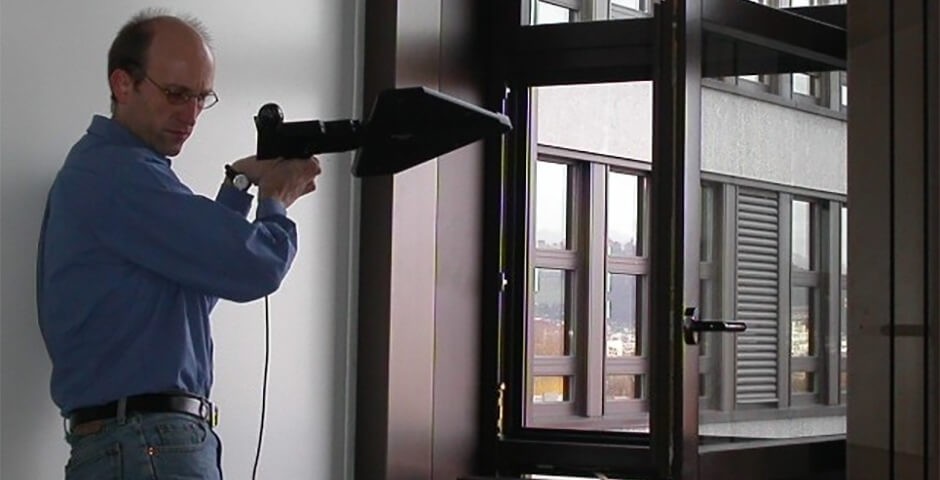
5G uses the latest generations of antennas, known as adaptive antennas. They consist of 64 or 128 radiating elements, and this is set to increase in the future. These elements target devices specifically and thus reduce scattering loss. Until now, mobile antennas have supplied entire sectors with signals in order to serve all devices within this area. What does this mean for the measurement of mobile signals?
Limitation of antenna transmitting power
Antennas for mobile communications, otherwise known as mobile base stations, are subject to a precautionary emission limitation in Switzerland. Their maximum transmitting powers are limited in accordance with the Ordinance on Protection from Non-Ionising Radiation.1 The maximum transmitting powers to which a mobile base station is limited is determined by calculating the incoming transmitting powers (immission) at inhabited locations in the vicinity of the mobile base station.
(1) ONIR, SR 814.710
Why acceptance measurements?
As the propagation of electromagnetic waves is influenced by many details, such as the material properties of buildings, which would require an unfeasible effort to determine, the above-mentioned field strength calculations have tolerances. Therefore, acceptance measurements are carried out after mobile base stations enter operation, in order to validate the calculated values. Such acceptance measurements have been carried out systematically for more than 20 years.
Measurement methods in the face of changing mobile technologies
Since mobile base stations emit maximum power only when traffic load is at its peak, measurement of the maximum field strengths is rarely or not at all possible. If the mobile base station is at maximum capacity, customers will also no longer be able to establish connections. This was and is annoying for customers and is therefore avoided as far as possible through predictive network planning.
As the propagation of electromagnetic waves does not depend on the transmitting power, as proven with GSM (2G) it is helpful to measure pilot signals with constant power from the air. By extrapolating the measured2 pilot signals to the maximum permitted transmitting power, compliance with the precautionary limit values can also be checked without any loss of quality, and without having to wait for a specific measurement time.
(2) In 2002, with GSM it was still possible to measure the BCCH pilot signals separately using standard spectrum analysers. Later, with UMTS, LTE and now also 5G, specialised measuring equipment is needed for pilot measurements in order to achieve the signal separation that is ultimately required.
5G and adaptive antennas
With the introduction of 5G, an innovation that was already being talked about at the time of UMTS (3G, introduced in 2004) is now becoming reality: adaptive antenna technology. The antenna housings on the transmission masts contain several individual radiating elements and if these are controlled with different signals, the transmitting power can currently be directed to where the customer wants to have a good reception signal on their device. Many 5G mobile base stations are equipped with them, but there are still also conventional antennas that supply signals uniformly and statically to an entire sector.
Adaptive antennas and pilot signals
As mentioned above – today’s 5G adaptive transmitting antennas differ from conventional antennas, as traffic and pilot signals are emitted from the antenna with different strengths depending on the direction of transmission. However, because the difference between the two signals is known depending on the direction, the measured 5G signal is now extrapolated by this difference up to the maximum permitted transmitting power in accordance with the measurement method of the Swiss Federal Institute of Metrology (METAS). This solution is internationally accepted by standards committees and is also proposed by measuring equipment manufacturers.
Reduced power due to theoretical maximum
Depending on the transmission direction in which the measurement is made, the direction-dependent extrapolation can be larger or smaller. The METAS 5G measurement method distinguishes between three cases and extrapolates the measurements more conservatively for which larger tolerances are assumed.
This ensures that the end result of such measurements tends to be above the installation limit value rather than below it, which then also means that the transmitting power is reduced because of the tolerance and not because of the measurement. Since the installation limit values, as mentioned at the beginning, are a restriction in accordance with the precautionary principle in the Environmental Protection Act,3 this would not present a health risk either. The international ICNIRP4 limits, which are 10 times higher and apply in Germany for example, represent the justified standard for this
(3) EPA, SR 814.01
(4) International Commission on Non-Ionizing Radiation Protection
